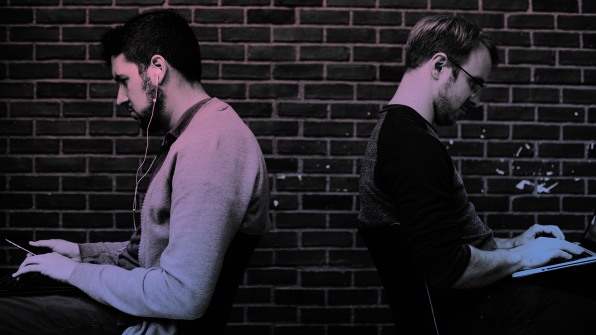
« I wake up in cold sweats thinking, what did we bring to the world ? »
Tony Fadell, one of the minds behind the iPod and the iPhone, mulls design’s unintended consequences.
By Katharine Schwab CO.DESIGN
Tony Fadell’s wife likes to remind him when their three children’s eyes are glued to their screens that it’s at least partly his fault.
Hard to argue. Fadell, who founded the smart thermostat company Nest in 2010 and who was instrumental in the creation of both the iPod and later the iPhone as a senior vice president at Apple, has done more to shape digital technology than many of his peers. But in a recent conversation at the Design Museum in London, Fadell spoke with a mix of pride and regret about his role in mobile technology’s rise to omnipresence.
“I wake up in cold sweats every so often thinking, what did we bring to the world?” he says. “Did we really bring a nuclear bomb with information that can–like we see with fake news–blow up people’s brains and reprogram them? Or did we bring light to people who never had information, who can now be empowered?”
Fadell was speaking as part of the Design Museum’s program around its current blockbuster exhibition, California, which examines the history and culture of digital technology in the Golden State, from early iPhone prototypes to the utopian festival and tech industry networking staple Burning Man to drawings of Apple Park. The conversation, called “Selling Freedom,” brought together Fadell; Bethany Koby, the cofounder and CEO of toy company Technology Will Save Us; David Edgerton, a historian of science and technology at King’s College London; and Judy Wajcman, a sociologist at the London School of Economics who studies the social impact of technology. They were charged with examining the consequences of having so much revolutionary technology coming from a single place.
The world Fadell describes is one in which screens are everywhere, distracting us and interrupting what’s important, while promoting a culture of self-aggrandizement. The problem? He says that addiction has been designed into our devices–and it’s harming the newest generation.
“And I know when I take [technology] away from my kids what happens,” Fadell says. “They literally feel like you’re tearing a piece of their person away from them—they get emotional about it, very emotional. They go through withdrawal for two to three days.”
At its root, this is a design problem. Fadell believes that products like the iPhone, as much as they are communication devices, are more attuned to the needs of the individual rather than what’s best for the family and the larger community.
Some of Silicon Valley’s history is rooted in the communal idealism of 1960s California, where technologists believed that a democratizing force called the internet was going to empower everyone through shared information. But Fadell says this philosophy has been perverted. The emphasis on community has been lost; instead, companies like Apple market their products by selling the notion of freedom, that technology is a liberating force for the individual. Fadell believes that’s partly because of who designed the seminal products and services of the digital age.
“A lot of the designers and coders who were in their 20s when we were creating these things didn’t have kids. Now they have kids,” he says. “And they see what’s going on, and they say, ‘Wait a second.’ And they start to rethink their design decisions.”
And it’s not just that these early Silicon Valley wunderkinds didn’t have children themselves–there were no women or minorities or older people around either, as sociologist Judy Wacjman points out. “Silicon Valley is notorious in particular for not being family-friendly,” she says. “It’s notorious for being full of young male designers. It’s great that they’re thinking about this now that they’re having kids, but I wonder if one could envision a different design community full of people of different sexes, full of people of different ages. Some of the design that you get is the reflection of the limited cultural understanding of the young guys who are doing the designing.”
How are these designers rethinking their choices now that they do have families? One example is many tech companies’ stalwart position that they act as platforms and are not responsible for the content that users post–a stance that has recently come under fire as Facebook’s algorithms enabled fake news about the election to spread faster than real news. Fadell points to Google, which owns YouTube, in particular: “It was like, [let] any kind of content happen on YouTube. Then a lot of the executives started having kids, [and saying], maybe this isn’t such a good idea. They have YouTube Kids now.” (Google bought Nest, the company Fadell started after leaving Apple, in 2014 for $3.2 billion, and Fadell left the company under less than favorable circumstances last year.)
“This self-absorbing culture is starting to blow,” he says. “Parents didn’t know what to do. They didn’t know this was a thing they needed to teach because we didn’t know for ourselves. We all kind of got absorbed in it.”
According to Fadell, this is largely a matter of unintended consequences–but that doesn’t free designers and developers from responsibility. Fadell wants there to be a Hippocratic oath for designers, where they pledge to work ethically and “do no harm.” “I think we have to be very cognizant of the unintended consequences, but also acknowledge them and then design them out–make sure that we are ethically designing,” he says. “This is the slowest technology will ever progress ever again in your life. It’s only speeding up. So what are we going to do as designers to bring that element in all the time?”
